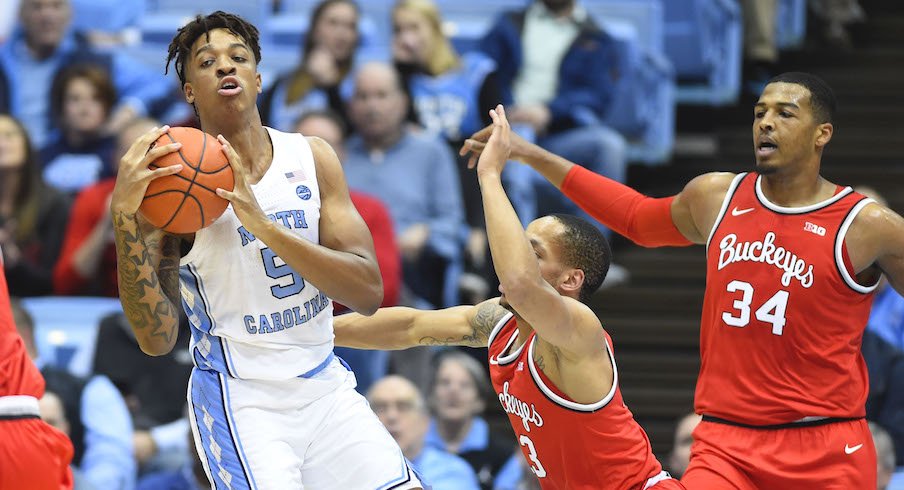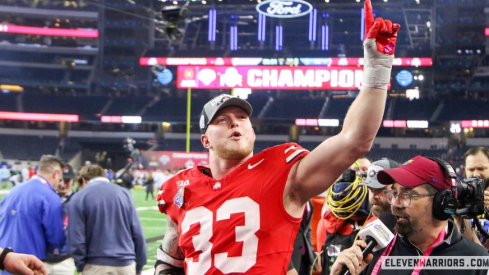CHAPEL HILL, N.C. – In the days leading up to sixth-ranked Ohio State’s 74-49 drubbing of No. 7 North Carolina, Ohio State spent a bit more time working on its defensive rebounding. Transition defense became more of a focus. Stopping Cole Anthony, a possible top-five pick in the 2020 NBA Draft, naturally was at the top of the scouting report.
Chris Holtmann, though, didn’t make any wholesale changes. He didn’t dial up a full-court press or a zone to try to hold the Tar Heels in check. Nothing crazy. He had no need to do so.
What worked defensively against North Carolina were the same scheme and basic principles that have worked throughout the season.
“It's been the same approach all year,” Duane Washington Jr. said. “Attention to details. Play really, really hard. Be the more tougher team. We came out, had a chip on our shoulder as we always do, and we came out and fought, fought hard.”
If that’s the norm, one has to wonder what this team might be capable of on the defensive end of the court throughout the season.
Ohio State didn’t just beat the Tar Heels on Wednesday night. It thoroughly dominated a top-10 team in historic fashion. Consider these records from the game:
- North Carolina shot its lowest field-goal percentage (27.4) in a single game in Dean E. Smith Center history.
- Ohio State’s plus-23 margin in the second half was the largest by any North Carolina opponent in Dean E. Smith Center history.
- North Carolina’s 49 points were the third-fewest it has ever scored.
- Ohio State’s 25-point win was the second-largest margin of victory by a visiting team in Dean E. Smith Center history.
In totality, the Buckeyes throttled a top-10 team with plenty of offensive firepower, beginning with Anthony.
“Obviously Anthony was the biggest point of emphasis and his ability to get in the lane and create his own offense,” Holtmann said. “We tried to put two to the ball a lot with him and then make the other guys kind of play over top of us.”
Luther Muhammad drew the matchup with Anthony to begin the game. He fell into foul trouble, though, playing just nine minutes, and CJ Walker spent much of the game defending the dynamic combo guard.
Together, they allowed Anthony to make just 4-of-15 shots for 15 points. All four of his makes came from beyond the 3-point arc, and multiple of them were impossible-to-defend launches from a couple steps behind the line. From 2-point range, Anthony missed all seven shot attempts.
With a trio of Muhammad, Walker and Andre Wesson at his disposal, Holtmann has found himself able to rely on different defenders against guards and wings. That allowed him to switch to Walker due to Muhammad's foul trouble with relative seamlessness.
“There's usually, between the three of those guys, we can put some other guys that may not be as far along defensively on the perimeter,” Holtmann said. “And that was the case tonight.”
No Tar Heel other than Anthony cracked double figures as a scorer.
On the other end of the court, Ohio State’s offense took a while to get rolling. In the first half, the Buckeyes shot 39.3 percent from the field and committed 10 turnovers compared to just three turnovers from North Carolina. Despite that disparity, they held on to a 29-27 lead at halftime, much of which can be attributed to quality defensive play. The Tar Heels scored just six points off of the 10 first-half turnovers, making just 28.6 percent of their shots in the opening 20 minutes.
Had the Buckeyes’ defense sputtered, North Carolina could have pulled away due to Ohio State’s self-inflicted turnovers. Instead, the lead allowed Holtmann to settle his team down at halftime and put together a 19-9 run in the first 7:17 of the second half, leading to a 12-point lead that it extended.
“Really pleased with the first six minutes of the second half,” Holtmann said. “I thought that was maybe our best basketball was the first six minutes. We settled down. We made smart decisions. We attacked them in certain areas. We made them work. I thought that was probably our best six-to-seven-minute stretch of the game, and that was critical.”
North Carolina managed to grab 13 offensive rebounds but scored just eight second-chance points. Roy Williams’ group couldn’t find a modicum of consistency on offense, especially in the second half when it made back-to-back shots just once. Though limited due to Armando Bacot’s in-game injury, the Tar Heels also scored only 10 points in the paint.
Notably, this wasn’t a one-off performance for Ohio State.
Eight games of evidence now exists. And in all eight games, the Buckeyes have wiped out all offensive hope from their opponents.
Seven of their eight opponents this season – Cincinnati, UMass Lowell, Villanova, Stetson, Purdue Fort Wayne, Kent State and North Carolina – both scored their fewest points and had their lowest shooting percentage of the season in games against Ohio State. None of them scored more than 57 points or shot better than 37 percent from the field when facing the Buckeyes. The only team that didn’t set season lows – Morgan State – lost by 33 points.
As of early Thursday morning, Ohio State ranks second in adjusted defensive efficiency, per KenPom, behind only Virginia.
“I'll be interested to see how this plays out, as I said when we continue to play similar competition over a longer stretch,” Holtmann said. “I think that's the real test of your group and how committed you are on that end. But certainly we've had a good start with some teams, for sure.”
The offense, Holtmann said, has progressed about as expected. Defensively, however, Ohio State finds itself more advanced than anticipated, he admitted.
If the first eight games are any accurate indication, the Buckeyes already have an identity. Good luck trying to score on them.


